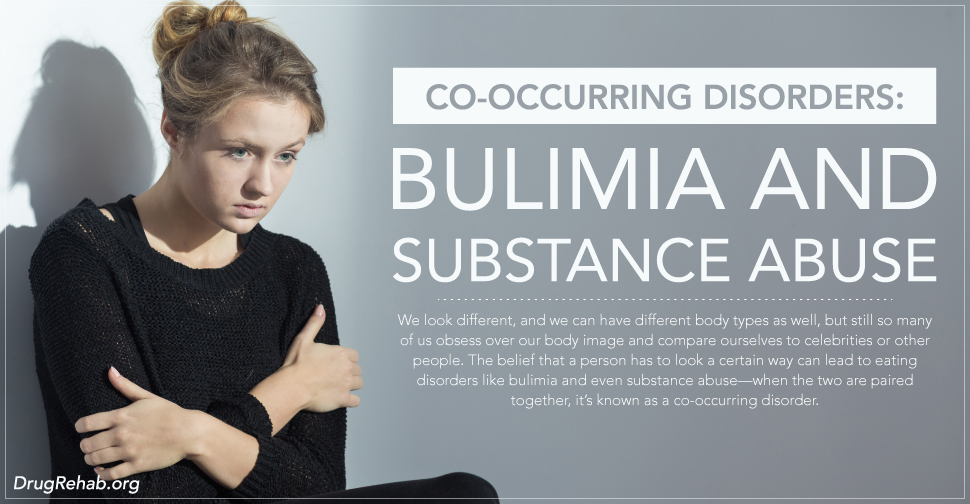
Bulimia is an eating disorder often characterized by a person’s low self-image, and inability to control the amount of food they eat. Binge-eating is a common occurrence for a person suffering from bulimia, and some might even purge along with it (throw up). Another result or cause of bulimia can be substance abuse—and there are certain drugs that will curb a person’s appetite or even make them lose weight. A co-occurring disorder is when a substance use disorder is paired with a mental disorder like bulimia.
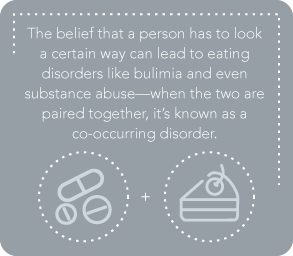 In a fast-paced world where so much is expected of us, beauty is often portrayed as slim, fit and tiny. This can be pretty stressful to try to deal with on a daily basis, and it’s important to realize that all people are different. We look different, and we can have different body types as well, but still so many of us obsess over our body image and compare ourselves to celebrities or other people. The belief that a person has to look a certain way can lead to eating disorders like bulimia and even substance abuse—when the two are paired together, it’s known as a co-occurring disorder.
In a fast-paced world where so much is expected of us, beauty is often portrayed as slim, fit and tiny. This can be pretty stressful to try to deal with on a daily basis, and it’s important to realize that all people are different. We look different, and we can have different body types as well, but still so many of us obsess over our body image and compare ourselves to celebrities or other people. The belief that a person has to look a certain way can lead to eating disorders like bulimia and even substance abuse—when the two are paired together, it’s known as a co-occurring disorder.
What Is A Co-Occurring Disorder?
Co-occurring disorders (dual diagnosis) are when a person has a mental disorder along with a substance use disorder. According to the Substance Abuse and Mental Health Services Administration (SAMHSA), “People with mental health disorders are more likely than people without mental health disorders to experience an alcohol or substance use disorder. Co-occurring disorders can be difficult to diagnose due to the complexity of symptoms, as both may vary in severity. In many cases, people receive treatment for one disorder while the other disorder remains untreated.”
Co-occurring disorders can come in a lot of shapes and sizes; most are complex and require special types of treatment. One type of co-occurring disorder is bulimia and substance abuse. By themself, each can be life threatening, but once paired together, they can be even more dangerous.
Definition Of Bulimia
Self-image, verbal abuse, and self-esteem can all contribute to bulimia—which can be extremely hard to deal with. “Bulimia is an eating disorder in which a person has regular episodes of eating a very large amount of food (bingeing) during which the person feels a loss of control over eating. The person then uses different ways, such as vomiting or laxatives (purging), to prevent weight gain” (U.S. National Library of Medicine).
Symptoms Of Bulimia
People with bulimia might be completely disgusted with themselves for reasons that seem over the top to others. It’s important to remember that mental illness comes with a lot of different signs and symptoms—and that a person suffering from them is not well. The symptoms of eating disorders like bulimia can include:
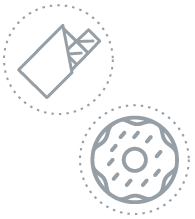
- Forcing oneself to vomit
- Excessive exercise
- Using laxatives, enemas, or diuretics (water pills)
- Suddenly eating large amounts of food or buying large amounts of food that disappear right away
- Regularly going to the bathroom right after meals
- Throwing away packages of laxatives, diet pills, emetics (drugs that cause vomiting), or diuretics
- Broken blood vessels in the eyes (from the strain of vomiting)
- Dry mouth
- Pouch-like look to the cheeks
- Rashes and pimples
- Small cuts and calluses across the tops of the finger joints from forcing oneself to vomit
- Have anorexia
- Have major depression
- Need medicines to help them stop purging
Bulimia can also lead to these complications:
- Stomach acid in the esophagus (the tube that moves food from the mouth to the stomach). This can lead to permanent damage of this area.
- Tears in the esophagus
- Dental cavities
- Swelling of the throat
(U.S. National Library of Medicine)
What Causes Bulimia?
The symptoms of bulimia can seem endless, but professionals don’t really know the specific causes. The U.S. National Library of Medicine states that “genetic, psychological, family, society, or cultural factors” can all contribute to this disorder. Behaviors are learned, and can essentially be un-learned with proper treatment and care.
Substance Abuse And Substance Use Disorders
Along with excessive exercise, weight loss, and lowered self-esteem, bulimia can lead to addiction to diet pills and other substances. Though some drugs can have a proper use, the use of some illicit drugs, like heroin or cocaine, is considered abuse.
“People use substances for a variety of reasons. It becomes drug abuse when people use illegal drugs or use legal drugs inappropriately. This includes the repeated use of drugs to produce pleasure, alleviate stress, and/or alter or avoid reality” (National Institute on Drug Abuse). Substance abuse and dependence can be intertwined to have one meaning of substance use disorder.

Even though substance abuse and substance use disorders don’t always have to be simultaneous, “substance use disorders occur when the recurrent use of alcohol and/or drugs causes clinically significant impairment, including health problems, disability, and failure to meet major responsibilities at work, school, or home” (Substance Abuse and Mental Health Services Administration).
Symptoms Of Substance Abuse
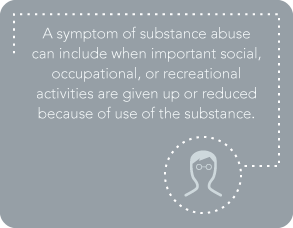 “The symptoms associated with a substance use disorder fall into four major groupings: impaired control, social impairment, risky use, and pharmacological criteria” (National Institute on Drug Abuse). One of the easiest ways to tell if you’re suffering from a substance use disorder is if you have withdrawals when you stop using the drugs, but there can be other symptoms that go along with substance abuse and in turn, a substance use disorder. According to the same source, some of those symptoms can be:
“The symptoms associated with a substance use disorder fall into four major groupings: impaired control, social impairment, risky use, and pharmacological criteria” (National Institute on Drug Abuse). One of the easiest ways to tell if you’re suffering from a substance use disorder is if you have withdrawals when you stop using the drugs, but there can be other symptoms that go along with substance abuse and in turn, a substance use disorder. According to the same source, some of those symptoms can be:
- The substance is often taken in larger amounts or over a longer period than was intended.
- There is a persistent desire or unsuccessful effort to cut down or control use of the substance.
- A great deal of time is spent in activities necessary to obtain the substance, use the substance, or recover from its effects.
- Craving, or a strong desire or urge to use the substance.
- Recurrent use of the substance resulting in a failure to fulfill major role obligations at work, school, or home.
- Continued use of the substance despite having persistent or recurrent social or interpersonal problems caused or exacerbated by the effects of its use.
- Important social, occupational, or recreational activities are given up or reduced because of use of the substance.
- Recurrent use of the substance in situations in which it is physically hazardous.
- Use of the substance is continued despite knowledge of having a persistent or recurrent physical or psychological problem that is likely to have been caused or exacerbated by the
- substance.
- Tolerance, as defined by either of the following:
- A need for markedly increased amounts of the substance to achieve intoxication or desired effect.
- A markedly diminished effect with continued use of the same amount of the substance.
- Withdrawal, as manifested by either of the following:
- The characteristic withdrawal syndrome for that substance (as specified in the DSM- 5 for each substance).
- The substance (or a closely related substance) is taken to relieve or avoid withdrawal symptoms.
How Can Bulimia Lead To Substance Abuse?
According to the professionals at SAMHSA, “People with mental health disorders are more likely than people without mental health disorders to experience an alcohol or substance use disorder.” One possible result of bulimia is abusing weight-loss medication—which can have nasty side-effects of its own.
The potential for addiction isn’t just with weight-loss medication, it can also include illicit drugs including (but not limited to) adderall, hydrocodone, opioids, heroin, and cocaine. These drugs are extremely addictive and can be dangerous, but they can also stop a person feeling hungry.
How Often Does Someone With Bulimia Eat?
“Eating binges may occur as often as several times a day for many months. The person often eats large amounts of high-calorie foods, usually in secret. During these episodes, the person feels a lack of control over the eating… People with bulimia are often at a normal weight, but they may see themselves as being overweight. Because the person’s weight is often normal, other people may not notice this eating disorder (U.S. National Library of Medicine).
Co-Occurring Disorder Statistics
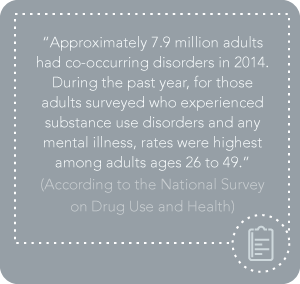 Since not all co-occurring disorders are treated for each disorder, the exact number of people who suffer from them is a bit skewed. According to the National Survey on Drug Use and Health, “approximately 7.9 million adults had co-occurring disorders in 2014. During the past year, for those adults surveyed who experienced substance use disorders and any mental illness, rates were highest among adults ages 26 to 49.”
Since not all co-occurring disorders are treated for each disorder, the exact number of people who suffer from them is a bit skewed. According to the National Survey on Drug Use and Health, “approximately 7.9 million adults had co-occurring disorders in 2014. During the past year, for those adults surveyed who experienced substance use disorders and any mental illness, rates were highest among adults ages 26 to 49.”
Mental illness and addiction know no age, race, or other demographic, but bulimia can sometimes be different be different. “Many more women than men have bulimia. The disorder is most common in teenage girls and young women. The person usually knows that her eating pattern is abnormal. She may feel fear or guilt with the binge-purge episodes” (U.S. National Library of Medicine).
Treatment Options For Co-Occurring Disorders
Some of the treatments used for co-occurring disorders are dialectical behavioral therapy, cognitive behavioral therapy, or a medication-assisted therapy. No matter which way a person wants to go, it’s very important to treat both disorders, but we realize that it can be difficult to determine whether or not you have a mental disorder, or a substance use disorder.
One thing is certain, not telling anyone about your potential problem, or not approaching a loved one about their problem does more harm than good. Furthermore, it can be hard to decide how to go about helping someone with an addiction or a mental illness—that’s what we’re here for.
How To Find The Right Treatment For You
If you, or a loved one are suffering from an addiction, or think you might have a co-occurring disorder, you’re not alone. Contact us today to speak to one of our addiction specialists, find out more about co-occurring disorders, and explore your treatment options. Addiction can be a losing battle, if you never ask for help.
For More Information Related to “Co-Occurring Disorders: Bulimia and Substance Abuse” Be Sure To Check Out These Additional Resources From RehabCenter.net:
- Dual Diagnosis: Sex Addiction And Mental Illness
- Environmental Risk Factors for Developing an Addiction
- Co-Occurring Disorders: Anorexia Nervosa And Substance Abuse
- Co-Occurring Disorders: Anxiety And Addiction
- Double Danger: Mental Illness, Addiction Often Linked
- Dual Diagnosis Alcohol and Drug Rehab
- How Do I Get My Loved One Into Rehab?
Sources
National Institute on Drug Abuse – The Science of Drug Abuse and Addiction: The Basics
Substance Abuse and Mental Health Services Administration – Co-occurring Disorders
Substance Abuse and Mental Health Services Administration – Behavioral Health Trends in the United States: Results from the 2014 National Survey on Drug Use and Health

